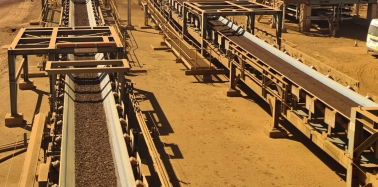What are the main wear parts of the conveyor belt
2025-04-22

Conveyor belts are essential components in various industries, facilitating the movement of materials from one point to another. They are widely used in manufacturing, mining, food processing, and logistics, among other sectors. However, like any mechanical system, conveyor belts experience wear and tear over time. Understanding the main wear parts of a conveyor belt is crucial for maintenance, efficiency, and safety. This article will discuss the primary wear parts of conveyor belts, their functions, and how to maintain them effectively.
The Conveyor Belt Itself
The conveyor belt is the most visible and essential part of the system. Made from materials such as rubber, PVC, or metal, the belt transports materials along its length. Over time, the surface of the belt can wear down due to friction, abrasion, and exposure to harsh environments. The primary factors contributing to belt wear include the type of materials being transported, the speed of the conveyor, and the environmental conditions. Regular inspections can help identify signs of wear, such as cracking, fraying, or thinning, allowing for timely replacement and reducing downtime.
Idlers and Rollers
Idlers and rollers are critical components that support the conveyor belt and facilitate its movement. They help reduce friction and maintain belt alignment. Over time, idlers and rollers can wear down due to constant contact with the belt and the materials being transported. Common issues include bearing failure, which can lead to increased friction and heat, causing further wear on the belt. Regular maintenance, including lubrication and inspection for misalignment or damage, can extend the life of these components and improve overall system efficiency.
Pulley Systems
Pulleys are used to redirect the conveyor belt and provide tension. They play a significant role in maintaining the belt's alignment and preventing slippage. Pulleys can experience wear due to the constant movement of the belt and the materials it carries. Common wear patterns include grooving, which can lead to belt misalignment and increased friction. Regular inspection of pulleys for signs of wear and ensuring proper tension in the belt can help mitigate these issues.
Belt Cleaners
Belt cleaners are essential for maintaining the cleanliness of the conveyor belt and preventing material buildup. They are typically installed at the discharge and return points of the conveyor. Over time, belt cleaners can wear down due to contact with the belt and the materials being transported. If not maintained, worn belt cleaners can fail to remove debris effectively, leading to increased wear on the belt and potential operational issues. Regular inspection and replacement of worn belt cleaners are crucial for maintaining optimal performance.
Skirting and Sealing Systems
Skirting and sealing systems are designed to contain materials on the conveyor belt and prevent spillage. They are typically made from rubber or other flexible materials that can wear down over time. Worn skirting can lead to material loss and increased housekeeping costs. Regular inspection and replacement of skirting materials are necessary to ensure proper containment and prevent environmental contamination.
Impact Beds
Impact beds are used to absorb the shock of materials being loaded onto the conveyor belt. They provide support and help protect the belt from damage during loading. Over time, impact beds can wear down due to constant contact with heavy materials. Worn impact beds can lead to increased wear on the belt itself, as well as potential misalignment. Regular inspection and replacement of impact beds can help maintain the integrity of the conveyor system and extend the life of the belt.
Conclusion
Understanding the main wear parts of conveyor belts is essential for effective maintenance and operation. Regular inspections and timely replacements of worn components can significantly enhance the efficiency and longevity of the conveyor system. By addressing wear issues proactively, businesses can minimize downtime, reduce maintenance costs, and ensure the safe and efficient transport of materials. Proper maintenance not only extends the life of conveyor belts but also contributes to the overall productivity of the operation. In an ever-competitive industrial landscape, investing in the maintenance of conveyor systems is not just a necessity; it is a strategic advantage.
Othe informations
Exploring the Applications of Acid-Alkaline Resistant Conveyor Belts in Harsh Environments
Exploring the Applications of Acid-Alkaline Resistant Conveyor Belts in Harsh Environments Table of Contents 1. Introduction to Acid-Alkaline Resistant Conveyor Belts 2. Importance of Acid-Alkaline Resistance in Conveyor Belts 3. Applications of Acid-Alkaline Resistant Conveyor Belts 3.1 Chemical Industry 3.2 Mining and Mineral Processing 3
Understanding Oil Resistant Conveyor Belts: Essential Insights for Industrial Professionals
Oil resistant conveyor belts are specifically designed to withstand the effects of oil and grease, making them a vital component in various industrial applications. These belts are crafted from materials that not only provide excellent durability but also have a high resistance to the degrading effects of oils, which can often lead to premature wear and tear in standard belts. One of the primary a
Choosing the Perfect Heat Resistant Conveyor Belt for Your Industrial Needs
Choosing the Perfect Heat Resistant Conveyor Belt for Your Industrial Needs Table of Contents Introduction to Heat Resistant Conveyor Belts Understanding Heat Resistance in Conveyor Belts Types of Heat Resistant Conveyor Belts Factors Affecting Heat Resistance Choosing the Right Heat Resistant Conveyor Belt Installation Tips for Heat Resistant Conveyor Belts Mainte

